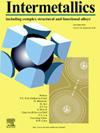Low activation Ti30V30Cr5Zr5Ta30-XWX refractory high entropy alloys with excellent mechanical properties and phase stability
IF 4.3
2区 材料科学
Q2 CHEMISTRY, PHYSICAL
引用次数: 0
Abstract
Although refractory high entropy alloys (RHEAs) have the potential to serve as nuclear materials, designing a high-performance alloy that can simultaneously endure extreme environments, such as elevated temperatures and radiation exposure, remains a significant challenge. In this work, elements with high melting points and low activation characteristics are selected to design Ti30V30Cr5Zr5Ta30-xWx (x = 5, 10, 15, 20 at.%) RHEAs that exhibit good high-temperature strength and irradiation resistance. The phase structure, mechanical properties, deformation mechanisms, and irradiation resistance of the RHEAs were investigated and discussed. All the low-activation Ti30V30Cr5Zr5Ta30-xWx RHEAs exhibited excellent phase stability. Typically, the Ti30V30Cr5Zr5Ta15W15 RHEA exhibited a yield strength, specific yield strength, and plasticity of 1607 MPa, 172.42 MPa·cm3/g and 22.7 % respectively at room temperature. At 800 °C and 1000 °C, it still had a yield strength of 851 MPa and 558 MPa respectively. The high strength of the Ti30V30Cr5Zr5Ta15W15 RHEA was attributed to the solid solution strengthening mechanism, in which the W element played an important role. The deformation mechanism of Ti30V30Cr5Zr5Ta15W15 RHEA at both room temperature and elevated temperatures was primarily governed by dislocation slip. Using low-energy and high-flux He ions, the irradiation resistance of the Ti30V30Cr5Zr5Ta20W10 and Ti30V30Cr5Zr5Ta15W15 RHEAs were also investigated. They demonstrated better radiation resistance surpassed that of pure W, showing remained flat surface and stable phase structure.

低活化Ti30V30Cr5Zr5Ta30-XWX耐火高熵合金具有优异的力学性能和相稳定性
尽管耐火高熵合金(RHEAs)具有作为核材料的潜力,但设计一种能够同时承受极端环境(如高温和辐射暴露)的高性能合金仍然是一个重大挑战。本文选择熔点高、活化特性低的元素,设计出具有良好高温强度和耐辐照性能的Ti30V30Cr5Zr5Ta30-xWx (x = 5,10,15,20 at.%) RHEAs。研究了该材料的相结构、力学性能、变形机理和耐辐照性能。所有低活化Ti30V30Cr5Zr5Ta30-xWx RHEAs均表现出优异的相稳定性。室温下,Ti30V30Cr5Zr5Ta15W15 RHEA的屈服强度为1607 MPa,比屈服强度为172.42 MPa·cm3/g,塑性为22.7%。在800℃和1000℃时,其屈服强度分别为851 MPa和558 MPa。Ti30V30Cr5Zr5Ta15W15 RHEA的高强度归因于固溶强化机制,其中W元素发挥了重要作用。Ti30V30Cr5Zr5Ta15W15 RHEA在室温和高温下的变形机制主要是位错滑移。采用低能和高通量He离子,研究了Ti30V30Cr5Zr5Ta20W10和Ti30V30Cr5Zr5Ta15W15的辐照性能。它们具有比纯W更好的耐辐射性能,表面保持平坦,相结构稳定。
本文章由计算机程序翻译,如有差异,请以英文原文为准。
求助全文
约1分钟内获得全文
求助全文
来源期刊

Intermetallics
工程技术-材料科学:综合
CiteScore
7.80
自引率
9.10%
发文量
291
审稿时长
37 days
期刊介绍:
This journal is a platform for publishing innovative research and overviews for advancing our understanding of the structure, property, and functionality of complex metallic alloys, including intermetallics, metallic glasses, and high entropy alloys.
The journal reports the science and engineering of metallic materials in the following aspects:
Theories and experiments which address the relationship between property and structure in all length scales.
Physical modeling and numerical simulations which provide a comprehensive understanding of experimental observations.
Stimulated methodologies to characterize the structure and chemistry of materials that correlate the properties.
Technological applications resulting from the understanding of property-structure relationship in materials.
Novel and cutting-edge results warranting rapid communication.
The journal also publishes special issues on selected topics and overviews by invitation only.
 求助内容:
求助内容: 应助结果提醒方式:
应助结果提醒方式:


